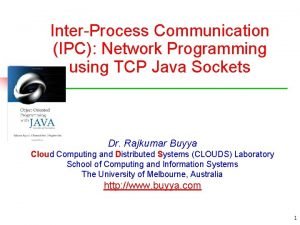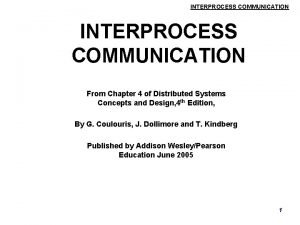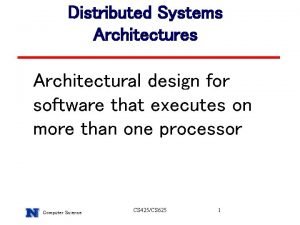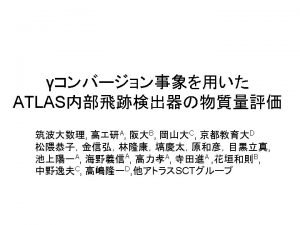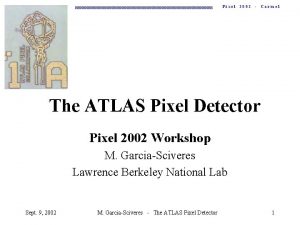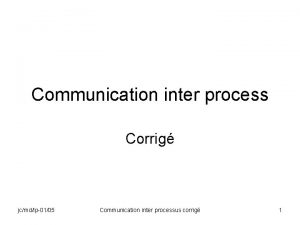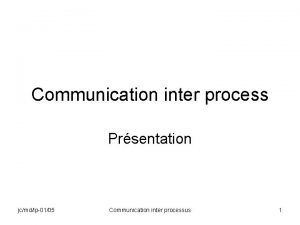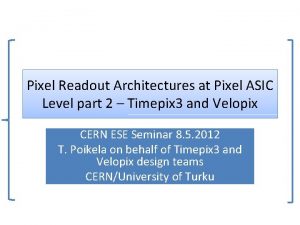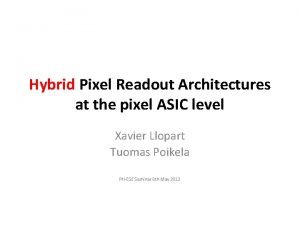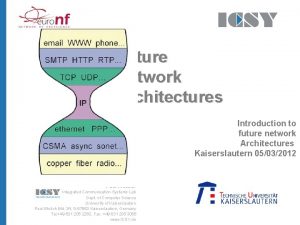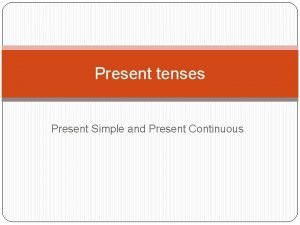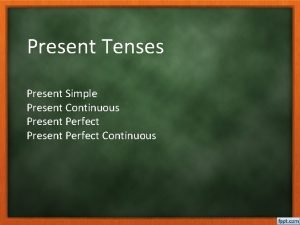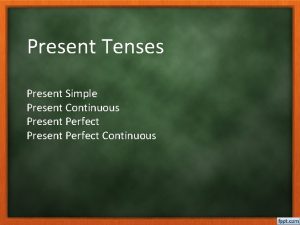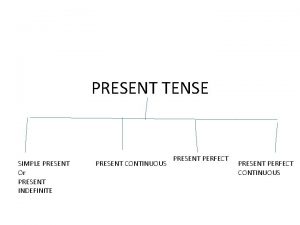PRESENT AND FUTURE INTER PIXEL COMMUNICATION ARCHITECTURES IN








![-9 - X [µm] Y [µm] Active Area Medipix 2 and Timepix 14111 -9 - X [µm] Y [µm] Active Area Medipix 2 and Timepix 14111](https://slidetodoc.com/presentation_image_h/21908ca87d1b7b16ad4bcfd7aa31fe32/image-9.jpg)





















- Slides: 30

PRESENT AND FUTURE INTER PIXEL COMMUNICATION ARCHITECTURES IN TIMEPIX/MEDIPIX DERIVED READ OUT CHIPS X. Llopart* *on behalf of the Medipx 3, Timepix 2 and VELOpix design teams

Outline • • • Technology motivation Medipix 3 Timepix 2 LHCb VELO upgrade → VELOpix (~2013) Conclusions

-3 - Technology motivation • The evolution in CMOS technology is motivated by decreasing price-perperformance for digital circuitry → increased transistor density Motivation Medipix 3 Timepix 2 VELOpix Conclusions • While this evolution in CMOS technology is by definition very beneficial for digital this is not so for analog circuits (low VDD, transistor leakage, …) WIT 2010, Berkeley (4 th February) X. Llopart

-4 - The Medipix 3 Collaboration Motivation Medipix 3 Timepix 2 VELOpix Conclusions • • • • • University of Canterbury, Christchurch, New Zealand CEA, Paris, France CERN, Geneva, Switzerland, DESY-Hamburg, Germany Albert-Ludwigs-Universität Freiburg, Germany, University of Glasgow, Scotland, UK Leiden Univ. , The Netherlands NIKHEF, Amsterdam, The Netherlands Mid Sweden University, Sundsvall, Sweden Czech Technical University, Prague, Czech Republic ESRF, Grenoble, France Universität Erlangen-Nurnberg, Erlangen, Germany University of California, Berkeley, USA VTT, Information Technology, Espoo, Finland ISS, Forschungszentrum Karlsruhe, Germany Diamond Light Source, Oxfordshire, England, UK Universidad de los Andes, Bogota, Colombia AMOLF, Amsterdam, The Netherlands ITER International Organization, Cadarache Centre, France WIT 2010, Berkeley (4 th February) X. Llopart

-5 - Medipix 2 simulation • The Medipix 2/Timepix devices (square pixels of 55 µm) show an energy spectrum distortion due to charge sharing between adjacent channels Motivation Medipix 3 Timepix 2 VELOpix Conclusions WIT 2010, Berkeley (4 th February) X. Llopart

-6 - Charge summing and allocation concept The winner takes all Motivation Medipix 3 Timepix 2 VELOpix Conclusions 55µm WIT 2010, Berkeley (4 th February) X. Llopart

-7 - Medipix 3 simulation • Pixel spectrum is reconstructed → Colour imaging Motivation Medipix 3 Timepix 2 VELOpix Conclusions WIT 2010, Berkeley (4 th February) X. Llopart

-8 - The Medipix 3 (2009) Motivation Medipix 3 Timepix 2 VELOpix Conclusions – – – – LVDS drivers and receivers (500 Mbps) Band-Gap and 25 DACs (10 9 -bit and 15 8 -bit) 32 e-fuse bits Eo. C and 2 Test pulse generators per pixel column Temperature sensor Full IO logic and command decoder TSV landing pads 17. 3 mm • Pixel matrix of 256 x 256 pixels (55 µm x 55 µm) • Bottom periphery contains: • Top periphery contains: – – – Power/Ground pads TSV landing pads Pads extenders • > 115 Million transistors • Typical power consumption: – – 600 m. W in Single pixel mode 900 m. W in Charge summing mode • 130 nm CMOS IBM-DM process WIT 2010, Berkeley (4 th February) 14. 1 mm X. Llopart
![9 X µm Y µm Active Area Medipix 2 and Timepix 14111 -9 - X [µm] Y [µm] Active Area Medipix 2 and Timepix 14111](https://slidetodoc.com/presentation_image_h/21908ca87d1b7b16ad4bcfd7aa31fe32/image-9.jpg)
-9 - X [µm] Y [µm] Active Area Medipix 2 and Timepix 14111 16120 87. 1% Medipix 3 top and bottom WB 14100 17300 81. 2% VELOpix Medipix 3 bottom WB 14100 15900 88. 4% Conclusions Medipix 3 top and bottom TVS 14100 15300 91. 9% Medipix 3 bottom TVS 14100 14900 94. 3% Motivation Medipix 3 Timepix 2 15. 3 15. 9 14. 9 17. 3 mmmm mm Multiple dicing options 14. 1 mm WIT 2010, Berkeley (4 th February) X. Llopart

Medipix 3 pixel Modes Pixel Operation Modes Single Pixel Charge Summing Colour Mode with charge Summing Pixel Gain Modes Motivation # Thresholds Fine Pitch Mode → 55 µm x 55 µm 2 Spectroscopic Mode → 110 µm x 110 µm 8 Linearity # Thresholds Medipix 3 High Gain Mode ~10 ke- Timepix 2 Low Gain Mode ~20 ke- Pixel Counter Modes Conclusions 2 Dynamic range # Counters 1 -bit 1 2 4 -bit 15 2 12 -bit 4095 2 24 -bit 16777215 1 # Active Counters Dead Time Sequential Count-Read (SCR) 2 Yes Continuous Count-Read (CCR) 1 No VELOpix -10 - Pixel size Pixel Readout Modes WIT 2010, Berkeley (4 th February) X. Llopart

Medipix 3 Pixel Schematic Motivation Medipix 3 Timepix 2 VELOpix Conclusions -11 - WIT 2010, Berkeley (4 th February) X. Llopart

Pixel Layout • Fully exploit the available 130 nm CMOS technology • Full custom layout fits ~1500 transistors per pixel Medipix 3 1. Preamplifier Timepix 2 2. Shaper VELOpix 3. Two discriminators with 5 -bit Conclusions -12 - 55 µm Motivation threshold adjustment 4. Pixel memory (13 -bits) 5. Arbitration logic for charge allocation 6. Control logic 7. Configurable counter 55 µm WIT 2010, Berkeley (4 th February) X. Llopart

Medipix 3 s-curve in charge summing mode • Energy of incoming particle is reconstructed after charge summing and hit allocation architecture Motivation Medipix 3 Timepix 2 VELOpix Conclusions -13 - 2 ke. Pixel 1 Pixel 2 WIT 2010, Berkeley (4 th February) X. Llopart

-14 - Imaging in CSM and SPM CSM SPM X-ray 60 k. V, 10 m. A, Acq=0. 1 s WIT 2010, Berkeley (4 th February) X. Llopart

Spectroscopic behavior (CSM and SPM) Am 241 CSM SPM

Pixel measurements summary Single Pixel Mode CSA Gain 11. 4 m. V/ke- CSA-Shapper Gain Motivation Non-Linearity Medipix 3 Timepix 2 VELOpix High Gain 34 n. A/ke- Low Gain 20 n. A/ke- High Gain <5% up to 10 ke- Low Gain <5% up to 20 ke- Peaking time ~110 ns Return to baseline Conclusions -16 - Charge Summing Mode High Gain <1. 5 µs for 12 ke- Low Gain <2. 5 µs for 25 ke- Electronic noise (unbonded) High Gain ~60 e-rms ~130 e-rms Unadjusted Threshold spread High Gain ~2300 e-rms ~3200 e-rms Adjusted Threshold spread High Gain ~150 e-rms ~210 e-rms Minimum threshold High Gain ~1100 e- ~1500 e- 8 µW 15 µW Pixel power consumption High Gain Low Gain WIT 2010, Berkeley (4 th February) X. Llopart

Timepix chip (2006) • Pixel matrix of 256 x 256 pixels (55 µm x 55 µm) • Pixels are configurable: Medipix 3 Timepix 2 VELOpix Conclusions -17 - Event counting TOT Arrival time • External clock (up to 100 MHz) is used as a time reference • Minimum threshold ~750 e • > 35 Million transistors • Typical power consumption <1 W with 100 MHz external clock • 250 nm CMOS IBM process 16. 12 mm Motivation – – – 14. 1 mm WIT 2010, Berkeley (4 th February) X. Llopart

-18 - Example - Timepix coupled to Ingrid 90 Sr with NEXT-4 in a B field of 195 m. T (M. Fransen, Nikhef) WIT 2010, Berkeley (4 th February) X. Llopart

From Timepix to Timepix 2 • Timepix chip (2006) architecture originally designed for imaging is used for single (or sparse multiple) event readout Motivation Medipix 3 Timepix 2 VELOpix Conclusions -19 - • Non triggerable • Full frame readout only – Serial readout (100 MHz): ~100 fps – Parallel readout (100 MHz): ~3000 fps • Either arrival time OR amplitude information • Timewalk > 50 ns (Preamp rise time ~100 ns) • 6 -metal CMOS 0. 25 μm WIT 2010, Berkeley (4 th February) X. Llopart

Timepix 2 requirements Motivation Medipix 3 Timepix 2 VELOpix Conclusions -20 - • • • Time resolution 1 -2 ns (local oscillator) Pixel size 55 x 55 µm Time stamp and TOT recorded simultaneously Triggerable externally Fast OR Sparse data only No event counting mode Configurable → HEP platform for many projects 8 -metal CMOS-DM 0. 13 μm WIT 2010, Berkeley (4 th February) X. Llopart

-21 - Timepix 2 proposed pixel architecture WIT 2010, Berkeley (4 th February) X. Llopart

Super pixel (4 x 4) • Advantages: Motivation Medipix 3 – Shared analog (bias, power) and digital (clock, common logic, etc) resources – Good to isolate analog from digital – Use standard cells in digital blocks as much as possible – Faster column readout (8 bit parallel bus) Timepix 2 VELOpix Conclusions -22 - • Disadvantages: – Lost of uniformity (not all pixels look the same): Different Cin and cross-talk – Efficient shielding must be designed to avoid cross-talk between digital and input WIT 2010, Berkeley (4 th February) X. Llopart

Preliminary proposed pixel architecture Motivation Medipix 3 Timepix 2 VELOpix Conclusions -23 - WIT 2010, Berkeley (4 th February) X. Llopart

Why an LCHb upgrade? • LHCb upgrade wants to increase the b-event yield by a factor >10 to efficiently address remaining open physics questions and aims to collect 100 fb-1 in 5 years Motivation Medipix 3 Timepix 2 VELOpix Conclusions -24 - • Increasing the luminosity x 10 is rather ‘easy’ for LHCb (enhanced beam focusing can be introduced at ‘any’ time and does not require an LHCupgrade). • Solution: Only a more sophisticated trigger can maintain good efficiencies. Decided not to rebuild new & more complex L 0 -trigger electronics, but execute the trigger algorithms on all data in software • A new DAQ system must transfer all, zero-suppressed front-end data straight into a large computer farm, through a huge optical network & router • All front-end electronics must be adapted or rebuilt to digitize, zerosuppress and transmit event data at 40 MHz WIT 2010, Berkeley (4 th February) X. Llopart

From VELO to VELOpix • The LHCb Vertex Detector (VELO, r-phi strip detector) will be replaced in ~2015 by an upgraded version of the Timepix chip high resolution pixel detector Motivation Medipix 3 Timepix 2 VELOpix Conclusions -25 - WIT 2010, Berkeley (4 th February) X. Llopart

Why pixels? Motivation Medipix 3 Timepix 2 VELOpix Conclusions -26 - • The square pixel (55 um x 55 um) results in equal spatial precision in both directions, removing the need for a double sided modules and saving a factor 2 in material • The extremely low occupancy (< 2 ppm) environment is ideally suited to the time-over-threshold conversion, as the efficiency will not suffer from the relatively large (1 us) dead time • It is a very ‘economic’ way (power & space) to obtain >6 bit digitization • Through-silicon-via technology allows a novel module assembly. • Average particle rate per BX • Average data rates (Gbit/s) 5. 8 10. 9 1. 4 3. 1 WIT 2010, Berkeley (4 th February) X. Llopart

VELOpix chip digital architecture (T. Poikela) • Data compression at super-pixel → pack and send pixels TOT value • Token pass column readout architecture (8 bit at 40 MHz → 320 Mbit/s) Motivation Medipix 3 Timepix 2 VELOpix Conclusions -27 - WIT 2010, Berkeley (4 th February) X. Llopart

Analog synergy between Timepix 2 and VELOpix Timepix 2 Analog requirements Motivation Medipix 3 Timepix 2 VELOpix Conclusions -28 - General working mode Pixel matrix Arrival time resolution TOT dynamic range Pixel architecture Layout architecture Readout Fast OR Readout speed VELOpix Very similar (see previous slide) Free-running or Triggered with Fully free-running programmable preset (40 Mfps) 256 x 256 25 ns (BX) / 1. . 2 ns 25 ns (BX) 8 -12 bits 4 bits Super Pixel: 4 x 4 Cluster together the digital parts of the pixel Sparse (token pass) 8 -bit parallel column readout Yes flexible ~fixed by experiment (serial to parallel) WIT 2010, Berkeley (4 th February) X. Llopart

Advantages of designing Timepix 2 before VELOpix Motivation Medipix 3 Timepix 2 • Timepix 2 is an approved project by the Medipix 3 collaboration with an assigned budget (2 -engineering runs) • Timepix 2 will be build in 130 nm IBM-DM reusing many blocks from Medipix 3 • Timepix 2 and VELOpix analog frontend have almost identical specs • The general working mode (Triggered vs Imaging) doesn’t exclude similar column readout schemes in both projects (4 x 4 clustering, 8 -bit column parallel bus, 40 MHz clock, …) VELOpix Conclusions -29 - • Due to the pixel logic density VELOpix will probably have to be designed in 90 nm (or even 65 nm? ) → Timepix 2 will be a very good tool to check most of the required functionality in the VELO upgrade. WIT 2010, Berkeley (4 th February) X. Llopart

Conclusions • Following Moore’s law ASIC designers are able to implement more functionality per pixel while maintaining the compact pixel area when a more downscaled process is used Motivation Medipix 3 • Medipix 3 uses a analog and digital inter-pixel communication in order to correct the effects of charge-sharing Timepix 2 VELOpix Conclusions -30 - • Timepix 2 and VELOpix are successors of the Timepix chip which will exploit the high integration density of deeper submicron technologies • The Timepix and VELOpix developments may have important lessons for the future Linear Collider Detector WIT 2010, Berkeley (4 th February) X. Llopart
 Future perfect and future continuous examples
Future perfect and future continuous examples Future perfect future continuous future perfect continuous
Future perfect future continuous future perfect continuous Database storage architecture
Database storage architecture Autoencoders
Autoencoders Future present continous
Future present continous Function of inter
Function of inter Java interprocess communication
Java interprocess communication External data representation and marshalling
External data representation and marshalling Building multi-threaded applications
Building multi-threaded applications Product architecture example
Product architecture example Ansi/sparc
Ansi/sparc Backbone network architectures
Backbone network architectures George schlossnagle
George schlossnagle Product architecture design
Product architecture design Gui architectures
Gui architectures Database system architectures
Database system architectures Cdn architectures
Cdn architectures Scalable web architectures
Scalable web architectures Three tier architecture of data warehouse
Three tier architecture of data warehouse Isa meaning in computer
Isa meaning in computer Browser/server architecture
Browser/server architecture Banking system architecture diagram
Banking system architecture diagram Backbone network architectures
Backbone network architectures Cache coherence for gpu architectures
Cache coherence for gpu architectures Why systolic architectures
Why systolic architectures Present simple present continuous past simple exercises
Present simple present continuous past simple exercises Past continuous present simple
Past continuous present simple Present simple past simple future simple present continuous
Present simple past simple future simple present continuous Passive present perfect progressive
Passive present perfect progressive Present perfect continuous tense active and passive voice
Present perfect continuous tense active and passive voice Present simple past simple future simple test
Present simple past simple future simple test






